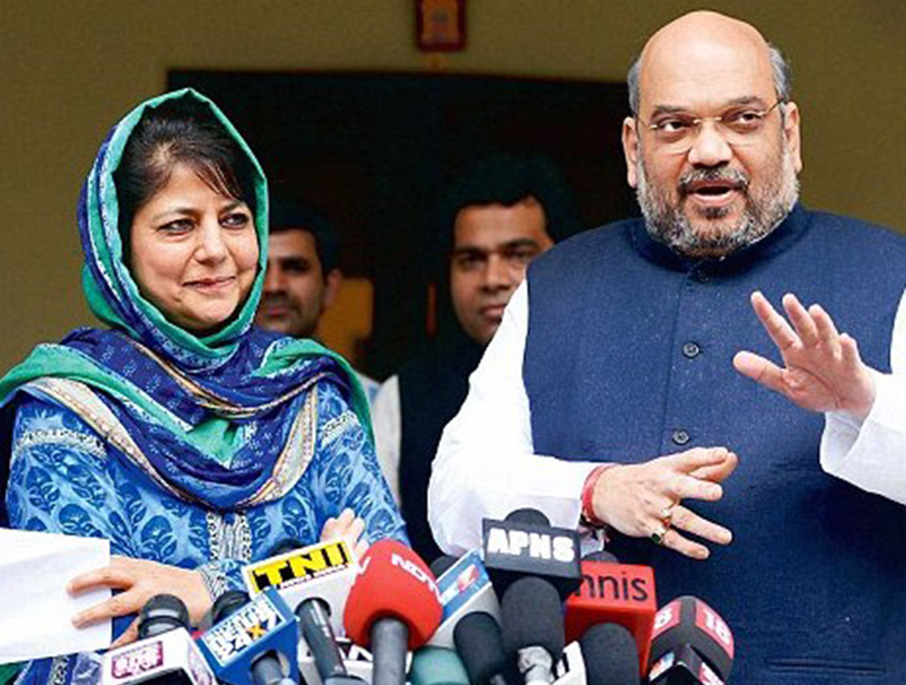Anuradha Bhasin Jamwal reads between the lines regarding the political alliance of BJP and PDP in Kashmir, interrogating the political frivolities and widening fissures between the functioning ideologies of the two parties.
Opposites are said to attract but that may not be quite the reason for Peoples Democratic Party coming closer to Bhartiya Janta Party to form a government in Jammu and Kashmir. The marriage between these two ideologically extreme formations has less to do with any kind of adulation and more to do with convenience and limitations of a hung verdict thrown by Jammu and Kashmir assembly elections that concluded well over two months ago. The monumental difficulties faced in forging this alliance, a done deal by now, taking such a long period, are both an indication of the fragility of the alliance between the two formations coming together for power and of the excessive complexities of Jammu and Kashmir’s socio-political landscape.By any yardstick, the PDP-BJP marriage is not an ideal one but one that is necessitated by limitations and compulsions. The hung verdict the recent elections threw was polarised along regional and religious lines with PDP winning 28 seats, 25 of which were from the Valley, and BJP winning 25 seats, mostly in Jammu region’s cow belt.
The PDP, the single largest party, had other options to explore with both its main traditional adversary National Conference with 15 seats and old alliance partner, Congress with 12 offering support to it for government formation. But it chose the BJP. PDP’s tilt towards BJP stems from various reasons. First, a grand alliance with both National Conference and Congress was unacceptable to the PDP in view of the traditional rivalry between the two main regional parties of the state. Any formation with Congress support and few independents was a possibility but numerically too weak and susceptible to various risks of crumbling. The PDP was also guided by two other factors. One is the regional composition of the Jammu and Kashmir assembly even though BJP understood to have an enormous Hindu representation from Jammu, neither had any presence in Ladakh, nor in the Valley, where all but one of their election candidates forfeited even their security deposits. Needless to point out that the Valley ignored the poll boycott call to keep BJP out of power. Second, there was the feeling that an alliance with BJP will ensure free flow of funds from the Centre and improve the working relations between the BJP government at the centre and the alliance government in Jammu and Kashmir. In a state where New Delhi carves itself a greater role in managing its affairs and in a state where BJP’s rise to power has been built on painstaking decade long work by RSS and Sangh Parivar to sharpen the communal divisions, the PDP’s apprehensions were not totally misplaced. The fact, however, remains that this saffron rise can be a serious impediment whether kept out of power formation or in it.
So, what would this PDP-BJP government-to-be eventually mean for Jammu and Kashmir? Would it be short-lived, fraught with infightings and perpetual tussles or can it deliver on the basis of the Common Minimum Programme that has been threshed out between BJP and PDP after several rounds of deliberations? The blue print of the CMP itself is a job well done, having sorted out tricky and contentious issues with jugglery of words and having focused on some key development areas. It includes the return of power projects to Jammu and Kashmir and the compensation for Indus Water Treaty, both issues if resolved could help bring the economy of the state on rails. However, much depends on how this CMP translates on the ground. Optimism needs to be peppered with a bit of caution, atleast, if not skepticism over how the two parties finally function as allies and in governance. The PDP-BJP coalition would be operating against huge odds and within certain limitations. The socio-political landscape within the state stands totally fragmented on regional and religious lines with deep rooted alienation and anger among various groups over different issues. This polarised situation stems from and adds to the feeling of neglect in Ladakh, the regional aspirations in Jammu with its complex sub-text of differing sub-regional aspirations and the stifling atmosphere of the Valley where human rights abuse and excessive as well as prolonged militarisation has created a situation where slight provocation is enough to bring the situation to a boil. This inheritance of loss is coupled with a huge sense of alienation at the grassroots, owing to lack of development, empowerment and employment in all the three regions. The CMP aims to turn this latter sense of alienation into an opportunity for both good governance and building bridges to narrow down the gaps. This would be a Herculean task.Apart from the huge alienation and deepening anger, due to various reasons, that the government-to-be is expected to address through good governance, both PDP and BJP have ideologies that are diametrically opposed. PDP in recent years came out with a Self Rule vision document that promoted autonomy for the state beyond its existing status under Article 370.
The BJP and the RSS have their own long pending cherished dream of abrogating the Article 370 and fully integrating Jammu and Kashmir into India. Dialogue with Pakistan and separatists is the centre-piece of PDP’s vision. The same is vehemently opposed by the Hindu right wing, even though the previous BJP led government under Atal Behari Vajpayee took the initiative of both brokering peace with Pakistan and inviting separatists for talks. Besides, PDP has been focusing on enlarging its base from the Valley to rest of the state by bridging divides on basis of development. In striking contrast, BJP’s politics thrives on divisive politics.
The PDP is hoping to enlarge its base vertically and horizontally across the state to meet the competing regional aspirations and the right wing aims to increase its footprints in Jammu and Kashmir to be in a position where it can comfortably push in its Hindutva agenda and conveniently overlook the regional aspirations which it has not as vociferously talked about as its contentious issues.
The latter’s politics has been dangerously based on sharpening the communal, ethnic and regional divides. Obviously, these motives that are completely antagonistic to each other would be at play even as the two parties try to focus on the other non-contentious issues. These desires would obviously tempt the two to be engaged in a constant tussle to decimate each other.
The government will be led by Mufti Mohammed Sayeed, whose shrewdness and capabilities to pull through several strains is undoubted. The challenge, however, lies in negotiating with an excessively powerful and RSS controlled BJP, not only as coalition partner, but also as a party at the helm of affairs at the Centre. Much will depend on how the national political scene would pan out in the coming months and years. The jolt to the BJP received in recent Delhi elections was a shot in the arm for Mufti, increasing his bargaining power with the saffron negotiators. A weakened BJP on the national landscape would well be in the interest of Jammu and Kashmir, making it difficult for the state unit of the BJP to push in the hardcore saffron agenda and keeping PDP engaged in reacting to its every move. Mufti can only pray for such an eventuality while also trying to ensure that the coalition sticks to the dotted line laid down by the CMP. Otherwise, the future looks bleak, both for the PDP and the state.













